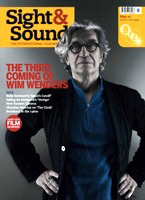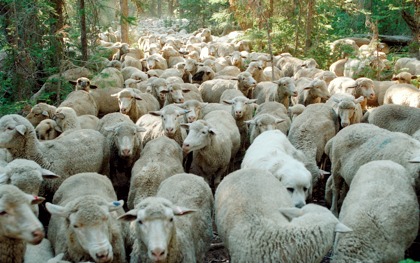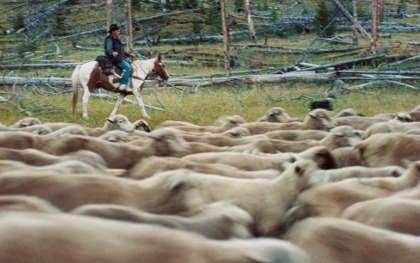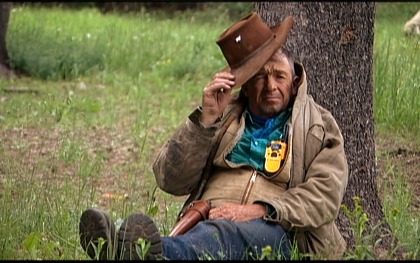Primary navigation


The sheep-herders’ life romanticised in Brokeback Mountain is the focus of the immersive new documentary Sweetgrass, which captures both the harshness and the grandeur of a vanishing world. By Kieron Corless
Strange to relate that one of the year’s most striking cinematic experiences so far is a documentary starring 3,000 sheep. They’re pretty much the first beings we encounter in Lucien Castaing-Taylor’s Sweetgrass, the thunderous multitude impressing itself on our ears initially, until eventually it pours from off screen into a fixed-camera shot – a cascading river of sheep in bleating tumult, corralled by dogs and herders down a gentle incline and off into the blurred distance, a seemingly irresistible and endless flow eventually arrested by an image of a lone sheep returning the camera’s studied gaze with placid curiosity.
Already in these opening scenes certain preoccupations become apparent, borne out as the film progresses. Collective experience will figure – and matter – as much as that of individuals, a dialectical back and forth. And the sheep will be anything but peripheral players; in Sweetgrass, evoking their apprehension of the world – and observing the relationship between humans and animals – will be central concerns.
Castaing-Taylor and Ilsa Barbash, who produced Sweetgrass, are academics based at Harvard, a husband-and-wife team who style themselves ‘visual anthropologists’; their previous films include Made in U.S.A. (1987), exposing child labour in Los Angeles, and In and out of Africa (1992), about the African art trade. The seeds of Sweetgrass were sown when the duo chanced upon a family of Norwegian-American herders in Montana who were among the last to trail their sheep inordinately long distances to public land up in the mountains for summer pasture, thanks to a grazing permit passed down over generations – a practice that’s existed since the 19th century.
Shooting over three years, Castaing-Taylor and Barbash were on hand in the Absaroka-Beartooth Mountains in 2003 to record a 150-mile sheep trail, which turned out to be the last one ever. Sweetgrass ends up being an understatedly lyrical record of the dying world of the herders and the disappearance of the old West – the curtailment of a particular relationship between humans and the natural world that will no doubt resonate widely.

The film opens in early spring with sheep-shearing and lambing, touches of frost and snow still lying on the ground. In these early stages, the film seems to be shaping up as a document of industrial farming processes along the lines of Nikolaus Geyrhalter’s Our Daily Bread (2005), as we observe super-fast, brutally efficient shearing performed by a line of workers manhandling the sheep into submission. That brutality spills over into the lambing, when newborns are tossed hither and thither in a bid to coax adoptive mothers, but is leavened by moments of tenderness – a typical dualism in attitude that’s replayed over and over in the ensuing journey. But once the trek across the mountains starts, the rhythms become less staccato, more diffuse. At this stage the herders are almost indistinguishable, and the camera often sits at sheep’s-eye level, magnetised by the creatures’ strangeness and mystery.
Finally just two herders remain: John Ahern and Pat Connolly (it’s never explained why the others leave). For the next weeks, until the end of summer, they’ll be in charge of this gigantic flock, on a journey fraught with difficulties and dangers – bears and wolverines, to name but two. John, the elder, is the more charismatic figure, straight from cowboy central casting; craggy and wizened, he’s a laconic outsider whom it’s hard to imagine anywhere but outdoors, working with the animals he clearly feels more comfortable with. In an attempt to render the camera’s presence near-invisible, Castaing-Taylor strapped it on himself in a shoulder harness, becoming literally a ‘recordist’ (a term he prefers to ‘director’), immersed in the unfolding events but not intervening in any way, instead simply observing as a way to bear witness and honour the subject.
Clarity is an illusion, Castaing-Taylor has declared, and Sweetgrass looks to bear out the truth of that statement. The film’s aesthetic strategies are of the ‘show, don’t tell’ variety, with viewers expected to work to get their bearings. There are no interviews or narration. Character is expressed through action rather than speech, for the most part, and what speech there is can be hard to understand – heavy dialect, or guttural noises directed at the sheep, dogs and horses. Very little information is provided; we’re not even made aware of the full significance of this journey until a closing title card tells us it was the last of its kind. Barbash and Castaing-Taylor prefer to let the images speak for themselves, and they’re often eloquent: the sheep-drive through a small town’s main street, for example – a surreal prospect, if ever there was one. Most of all, that refusal of spoon-fed clarity bespeaks a rigour and scrupulous restraint.
If all that makes Sweetgrass sound worthily spartan or even – given the directors’ day jobs – academic, the experience of watching it is anything but. The journey winds through some awe-inspiring scenery, the camera always alert to the play of light, shadow, colour and texture – a summer orange sunset spilling over the sheep as they wind down a track – with occasional zoom-ins and pull-backs producing dramatic shifts in scale and perspective. The recordists’ averred ideal of a judicious mingling of documentary and more artistic impulses is most apparent in the immersive sound design: up to eight sheep and herders were miked up at any given moment, now and then edited to produce gently disorienting disjunctions between what we’re seeing and hearing. The resulting sense of fragmentation – of not quite standing on solid ground – gives some idea of what an incredibly complex and demanding task herding this amount of sheep can be.

The herders’ microphones also serve – as much if not more so than the imagery – to lay bare the tensions at the heart of this enterprise, most obviously between received notions about cowboys’ lives, endlessly promulgated in films about the West, and the bruising actuality. Pat sometimes struggles to stay on top of the job, at one point addressing the sheep in an explosive rant long on expletives Tony Soprano might blanch at – a moment that’s hilarious and sad all at the same time. The harshness of the herders’ lives is framed by an impossibly beautiful landscape, a dichotomy captured most precisely and poignantly during another of Pat’s despairing outbursts, this time on the phone to his mother: “I’d rather enjoy these mountains than hate them, but it’s getting to the point I’m starting to hate ’em.” Among other things, Sweetgrass is a heartfelt lament – but one with a level gaze, entirely free of sentimentality and nostalgia.
It joins a small but significant band of recent films, broadly anthropological or ethnographic in nature, recording ways of living and working that are on the verge of obsolescence – films by the likes of Wang Bing, Feng Yan, Sharon Lockhart, Uruphong Raksasad and Eugenio Polgovsky. Sweetgrass is a fine addition to their number, not least in its mode of address to its subject – respectful, questioning, intelligent, even angry on some level. You wouldn’t want to push the analogy too far, but the quality of attention it requires and instils – the dedication and perseverance – feel as anachronistic and endangered in today’s corporate film culture as the people and ways of life being documented.
We learn from a title card at the end that the Raisland-Allestad Ranch in Sweetgrass County Montana, where the film began, shut down in 2004, after more than a hundred years of existence. Just before that we’ve seen John, at the culmination of the journey, driven off in a pick-up truck. “What will you do now?” the driver asks, a little too pointedly. As ever, John’s reply is evasive and halting, but his stoic resignation is underwritten with unease and anxiety, his plight representative of that of many others heading towards a similarly uncertain and precarious future.
Lucien Castaing-Taylor talks about the making of Sweetgrass on page 51 of the May 2011 issue of Sight & Sound
sleep furiously reviewed by John Banville (June 2009)
Our Daily Bread reviewed by Kieron Corless (February 2008)
Lonesome cowboys: Brokeback Mountain director Ang Lee talks to Roger Clarke (January 2006)
Climb every mountain: Nick James on Sight & Sound’s films of 2005, led by Brokeback Mountain (January 2006)
Le Souffle reviewed by Ryan Gilbey (May 2003)